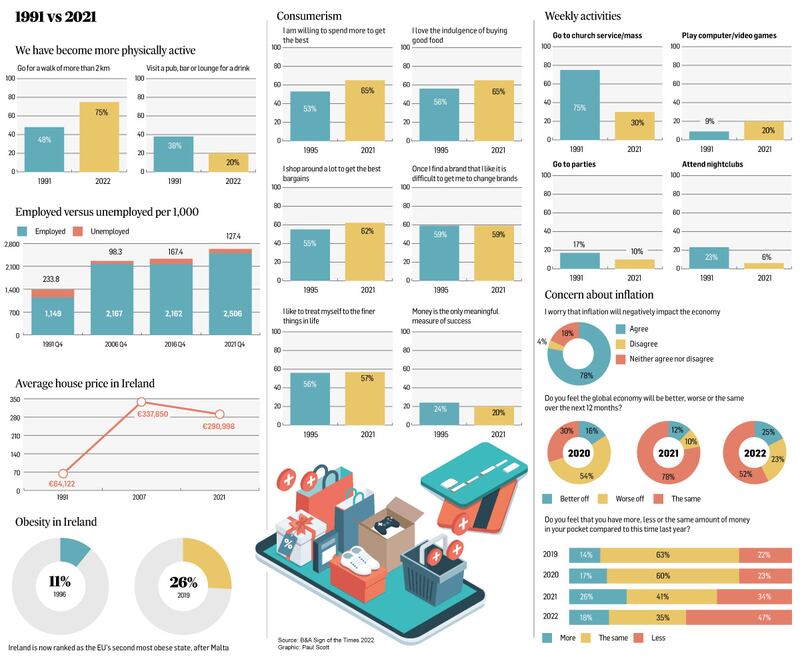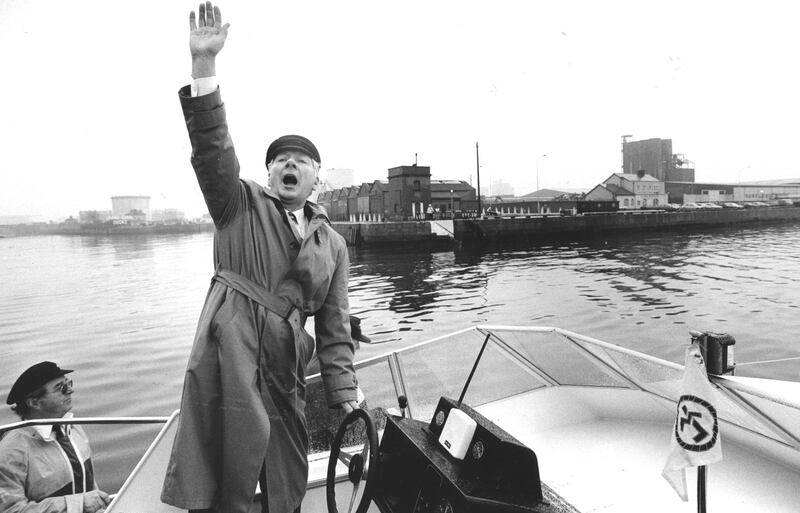It is hard to escape a sense of creeping cognitive dissonance when looking at the latest Behaviours and Attitudes (B&A) Sign of the Times survey which this year shines a spotlight on then and now, comparing the Ireland of the early 1990s with the Ireland of today.
Looking at many of the positive measures highlighted in the report, the country should be a fitter, happier and more productive place to be than it was back in what are – alarmingly for many people of a certain age who still think the 1990s were very recent – now the “rare auld times”.
The survey makes it clear that Irish people are much better educated than in times past, more worldly and as likely to be found in the local gym as the local pub.
They walk more – for fitness rather than to get from A to B – and they care more about their wellbeing. They have a greater understanding of how food works and why eating 15 potatoes and a pound of sausages with a side order of breakfast roll, all washed down with a feed of pints five times a week, might not be the most direct route to a long and healthy life.
READ MORE
But – as the B&A study makes very clear – despite all the activity and the awareness around food, we keep getting larger, with the numbers who can be classified as obese growing over the 30 years.

When it comes to the nation’s weight, there has been a steady increase in the rate of obesity over the last three decades. In the early 1990s, the percentage of Irish people who were obese was put at 11, rising to 26 per cent today – a figure that ranks Ireland as the EU’s second most obese state behind Malta.
The overall cost of obesity is set to rise to €5.4 billion annually over the course of this decade with the health service bearing much of the cost, something that is likely to put even more pressure on the healthcare system. The pressurised healthcare system is viewed as the single most important issue facing society by half of those polled by B&A.
This unenviable ascent up the EU weight scales has come despite a dramatic increase in the rate of exercise and physical activity, the research suggests.
While just 48 per cent of people in 1991 regularly walked more than 2km for exercise purposes, three-quarters now do so – a figure, researchers say, that was most likely boosted by habits learned during the early part of the Covid-19 pandemic when people had nowhere to go and little else to do for fun but go for yet another stroll.
When asked if they took part in any other form of exercise or physical activity, 11 per cent answered in the affirmative in 1991 compared with 32 per cent now. Hard as it may be for some younger people to believe , visits to gyms and yoga studios were virtually unheard of in 1991 with the percentage of the population doing either put at a less than impressive zero, according to B&A.
Fast forward to today and the numbers regularly visiting gyms has jumped to 17 per cent, or almost one in five adults, while 5 per cent of us are seeking a combination of inner calm and outer flexibility with the aid of our yoga teachers.
The popularity of running – a pursuit that would have been referred to as jogging when pollsters were posing the questions in the 1990s, incidentally – has also climbed dramatically, from 8 per cent then to 22 per cent now. Cycling has also become more popular, albeit more marginally, going up from 15 per cent to 17 per cent.

Squash and fishing, by contrast, have seen their fortunes tank with both falling in popularity from 3 per cent to 1 per cent.
It is not only our leisure pursuits that have changed. So too has our diet, with garlic and wine being the big winners. Our use of the former has soared from 17 per cent in 1991 to 47 per cent now, while our taste for the latter has jumped from 9 per cent in the 1990s to 28 per cent these days.
There has also been a reduction in snacking between meals and an increase in low-fat or diet products. Convenience has become an important aspect of eating, with 30 per cent buying food from a takeaway weekly compared to 21 per cent in 1991, while 20 per cent eat ready meals weekly compared with just 3 per cent in 1991.
There appears to be more conscientious thinking in regard to diet and healthy eating, with increased willingness to pay more for foods that do not contain artificial additives. That number is put at 42 per cent in the 1990s compared with 57 per cent now and when it comes to checking labels to avoid certain ingredients in foods, the figure has risen from 34 per cent to 48 per cent.
In the early 1990s, a visit to a restaurant was almost inevitably connected to a special occasion such as an anniversary, a birthday or – if it was during the daytime – a Communion or Christening, while nowadays people are far more likely to go to a restaurant for lunch or dinner for no reason other than they are in the mood for enjoying a meal out.
Other formerly popular social activities have not fared so well. While the pub could hardly be said to be in terminal decline, only one in five people regularly visit one for a drink now compared with 38 per cent back in the day. The nightclub would seem to have had its day. In the early 1990s as many as one in four adults went to such places to dance the night away to the Shamen and the Stone Roses, or perhaps Bryan Adams and Cher, depending on where they happened to fall on the coolness scale. The percentage who go to night clubs is now barely more than 5 per cent.
There has been a decline in more prudent behaviours, with fewer people likely to save for a rainy day or seeing the merits in being well insured, while there has also been a move toward making decisions quicker based on “gut”.
We are also increasingly anxious about what the future might hold and living in an era of what is termed “hyper uncertainty” but still less likely to prepare ourselves for that uncertain future, while our reliance on technology and the atomisation of society is gathering pace.
The survey points to “monumental developments” in women’s fight for equality. Attitudes towards women in Irish society appear to have improved significantly – although rather than lauding that fact many might marvel at how bad things once were and highlight further room for improvement.
According to the research, 88 per cent now believe mothers with young children can work outside the home and still be good mothers compared with 71 per cent in 1991. Meanwhile, 24 per cent are of the view that abortion is always wrong compared with 66 per cent in 1991. Sixty-one per cent believe the sexual freedom seen today is a very good thing; the percentage was 49 in the early 1990s.

While women still fall below men when it comes to the rate of employment, the percentage of women in the workplace now is almost 20 per cent higher than it was in the 1990s. When it comes to the gender pay gap, Ireland appears to be performing better than the EU average and most other English-speaking nations, with the exception of New Zealand. However, for every €1 a man in Ireland earns, a woman gets 86 cent – representing a 14 per cent gender pay gap.
The survey also points to increases in the number of one- and two-person households in 2021, compared to 2006 and 2016, alongside a steadily decreasing number of people in each household since 1991. According to the pollsters, this highlights the increased individualisation within the household, with fewer people having children. For those who do have children, they are having fewer children than people did in 1991.
The numbers going to weekly mass have plummeted from 75 per cent in 1991 to 30 per cent now while the numbers using computers have gone in the opposite direction, from 7 per cent to 78 per cent. Just more than one in 10 people used bottle banks in the 1990s compared with 50 per cent now, while only 3 per cent of people used recycling centres then compared with 47 per cent today.
There was a slight decline in agreement with one of the more depressing statements people were given as part of the research. When shown the sentence “Money is the only meaningful measure of success” in the 1990s, 24 per cent of people agreed. Today that percentage is put at 20 per cent.











